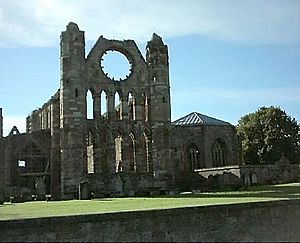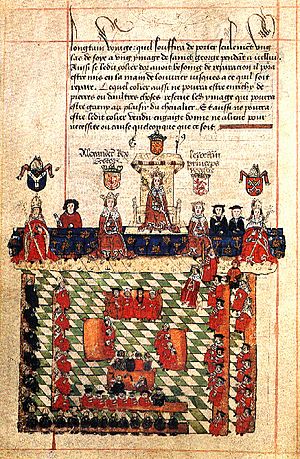Andrew Moray facts for kids
Quick facts for kids
Andrew Moray
|
|
|---|---|
| Personal details | |
| Born | Scotland |
| Died | 1297 |
| Cause of death | Due to wounds received at the Battle of Stirling Bridge |
| Children | Sir Andrew Murray |
| Parents | Sir Andrew Moray of Petty an unnamed daughter of John Comyn I of Badenoch |
| Relatives | David Moray (uncle) |
| Occupation | Military leader |
| Military service | |
| Allegiance | Kingdom of Scotland |
| Years of service | 1297 |
| Rank | Commander |
| Battles/wars | First War of Scottish Independence: |
Andrew Moray was a brave Scottish leader. He played a very important part in the First War of Scottish Independence. This was a time when Scotland fought for its freedom from King Edward I of England.
In the summer of 1297, Andrew Moray gathered a small army. He started his fight against the English king from Avoch Castle. He was very successful in taking back control of northern Scotland. Later, his army joined forces with William Wallace's army. Together, they led the Scots to a great victory at the Battle of Stirling Bridge on September 11, 1297. Moray was badly hurt in this battle. He died later that year from his injuries.
Contents
Who Was Andrew Moray?
Andrew Moray was born in Scotland in the late 1200s. We don't know the exact date or place. His father was Sir Andrew Moray of Petty. His father was a very important judge in northern Scotland.
The Moray family was rich and powerful. They owned a lot of land in Moray, a region in north-east Scotland. Their family history went back to a man named Freskin. He was given land in Moray in the 1100s. He built a castle called Duffus Castle near a large lake.

The Moray Family's Importance
When the Scottish Wars of Independence began, the Moray family was well-known. Sir Andrew Moray, Andrew's father, owned many lands and castles. These included the lordships of Petty, Avoch, and Boharm. Andrew Moray was set to inherit all these lands.
The family also had a lot of political power. Sir Andrew was the king's main law officer in northern Scotland. He also had strong connections to other powerful Scottish families. His first wife, Andrew's mother, was from the Comyn family, a very influential group.
Andrew's uncle, Sir William Moray of Bothwell, was also very wealthy. He was building a huge castle, Bothwell Castle, overlooking the River Clyde. This castle showed how powerful and important his family was. Andrew was also set to inherit his uncle's lands.
The Moray family also had ties to the church. An ancestor, also named Andrew, was a bishop in the 1200s. He helped build the beautiful Elgin Cathedral. Andrew's uncle, David, was also a church leader. He later became a bishop and supported King Robert Bruce.

Scotland in Trouble
The late 1200s were a difficult time for Scotland. In 1286, King Alexander III died suddenly. He fell from his horse. The king had no living children. So, the crown went to his three-year-old granddaughter, Margaret, Maid of Norway. Sadly, she died on her way to Scotland.
Many Scottish nobles wanted to become king. They asked King Edward I of England for help. Edward was a respected king. He agreed to decide who should be the next king of Scotland. But, the Scottish nobles had to accept him as the "Overlord" of Scotland. This meant he had power over their kingdom.
The two main people who wanted to be king were John Balliol and Robert Bruce. King Edward chose John Balliol. Most Scots accepted this decision.
King John Balliol agreed that Edward was his overlord. But King Edward started to get involved too much in Scottish affairs. This made the Scots very unhappy. By late 1295, King John decided to break away from Edward. He made a treaty with France instead. King Edward was furious. War between England and Scotland became certain.
English Invasion and Defeat
In the spring of 1296, Andrew Moray joined the Scottish army. They were getting ready to fight England. Some Scottish forces attacked northern England. They caused a lot of damage.
King Edward gathered a huge army. On March 30, he attacked the Scottish town of Berwick. There was a terrible slaughter of people there. The English army was much stronger than the Scots. At the Battle of Dunbar, the Scots were quickly defeated. Many Scottish soldiers died.
Scotland had to give up. King Edward removed King John from power at Montrose castle. He took away all the symbols of Scottish kingship. King John was even called "Toom Tabard," meaning "Empty Coat." King Edward then traveled through Scotland, all the way to Elgin. He made many Scottish nobles promise loyalty to him.
Many Scottish nobles captured at Dunbar were sent to English prisons. Andrew Moray's father, Sir Andrew Moray of Petty, was sent to the Tower of London. He died there in 1298. Andrew Moray the younger was sent to Chester Castle.
The Scottish Rebellion Begins
King Edward put English officials in charge of Scotland. They collected heavy taxes. They also tried to force Scots to join the English army to fight in other countries. These things made the Scots very angry.
Andrew Moray was still in prison at Chester Castle. But sometime in the winter of 1296-1297, he escaped! We don't know how he did it. Moray made his way back to his family's lands in northern Scotland.
In May 1297, the Scots began to rebel. Andrew Moray openly challenged English rule at Avoch. At the same time, William Wallace led an attack in Lanark. News of Moray's actions spread quickly. Many people joined him. Even though Andrew's father was still in prison, many of his tenants joined his son.

Moray Attacks Urquhart Castle
In 1297, there were many attacks against the English. Andrew Moray led the rebellion in the north. Sir Reginald Cheyne, an English sheriff, was worried. He asked King Edward for help.
Sir William fitz Warin, the English leader of Urquhart Castle, was ambushed by Moray's forces. He managed to escape back to his castle. The next day, Moray began to besiege the castle. The Countess of Ross arrived and told Sir William to surrender. He didn't, and Moray couldn't capture the castle that night. But Moray continued his fight in the area.

Moray's Success in the North
Andrew Moray continued his strong campaign against the English. He gained more supporters. English-held castles across northern Scotland began to fall to him. Even Castle Urquhart eventually fell.
Moray's campaign was very successful, but not much was written about it. Some of his actions were even later wrongly given to William Wallace. For example, some stories say Wallace attacked the port of Aberdeen and burned English ships. But it's more likely that Andrew Moray did this.

King Edward I was busy preparing for a war in another country. He tried to deal with Moray by releasing some Scottish nobles from prison. He hoped they would fight for him. But these nobles did not fully cooperate. They met Moray's army near the River Spey. There was no big battle. It seems both sides didn't want to fight each other.
Meanwhile, William Wallace was leading a rebellion in central Scotland. In the south, other Scottish leaders also rebelled. King Edward tried to make a deal with Andrew Moray. He offered to release Moray's father from prison if Andrew took his place as a hostage. But Andrew Moray ignored this offer. His father remained in prison and died there.
The Battle of Stirling Bridge
By late summer 1297, King Edward had little control over Scotland. Most of the country was in chaos. Only a few castles remained in English hands.
The English commander, the Earl of Surrey, finally decided to act. He gathered an army and marched into central Scotland. Moray and Wallace left their siege of Dundee castle. They marched their army to Stirling. They placed their forces near the old bridge over the River Forth, close to Stirling Castle.
The Earl of Surrey made a big mistake. He sent his army across the narrow bridge. Moray and Wallace waited. When only part of the English army had crossed, they attacked! The English forces on the other side of the bridge were trapped and destroyed. This was the Battle of Stirling Bridge. The rest of Surrey's army fled in panic.
The English lost many soldiers and knights. One important English leader, Hugh de Cressingham, was killed. The Scottish army's losses were not recorded, except for one important person: Andrew Moray.
The victory at Stirling Bridge was the peak of Moray's fight against King Edward. He was a skilled military leader. His training as a baron's son prepared him to lead soldiers in battle.
Andrew Moray's Death
There are different ideas about when Andrew Moray died. Some records say he was "slain at Stirling against the king." This means he died during the battle.
However, two letters sent after the battle still mention his name. One letter from October 11 was sent by "Andrew de Moray and William Wallace, leaders of the kingdom of Scotland." Another letter from November 7 was also from "Andrew de Moray and William Wallace, the leaders of the army and of the realm of Scotland." After these letters, Moray's name doesn't appear on any other documents.
Most historians believe Moray was badly wounded at Stirling Bridge. They think he died from his injuries around November 1297. Some historians argue he died right at the battle. They suggest Wallace might have kept using Moray's name in letters. This would have given more authority to Wallace's actions. It also helped Wallace deal with other Scottish nobles who might have been jealous of his power.
Andrew Moray's Legacy
Andrew Moray died young, so his achievements are not as well-known as William Wallace's. But his role was very important. In 2009, a Scottish politician suggested a monument to Moray. He wanted to make more people aware of Moray's historical importance. Some historians now say his actions were "the greatest threat to the English government" at that time.
Andrew Moray's widow gave birth to his son, also named Andrew, in 1298. This son later became a powerful leader himself. He played a big part in stopping King Edward III of England from conquering Scotland in the 1330s. He even served twice as a guardian for King David II.
See also
 In Spanish: Andrew de Moray para niños
In Spanish: Andrew de Moray para niños





